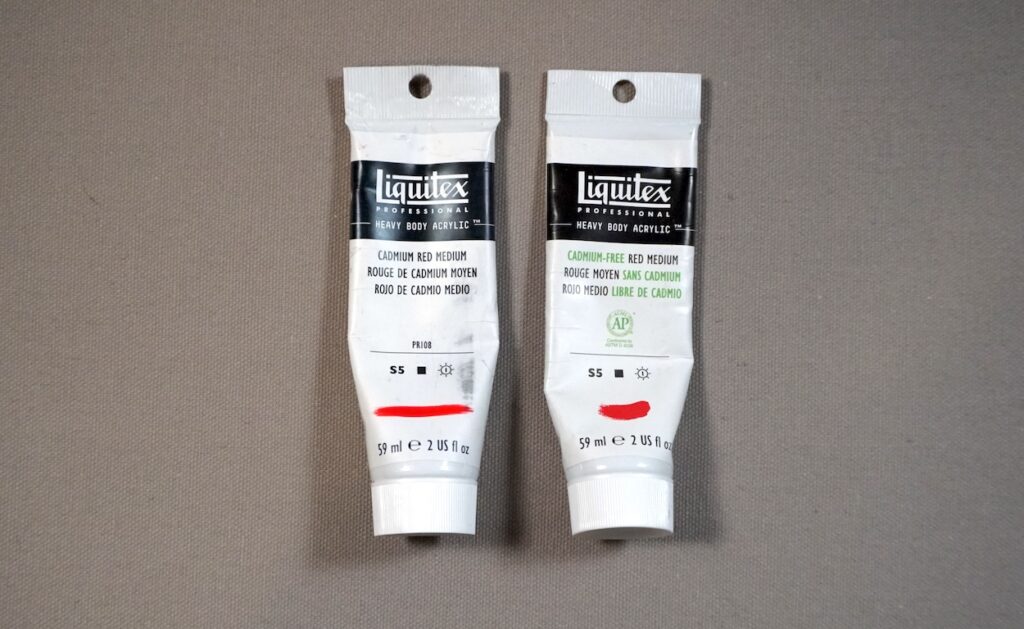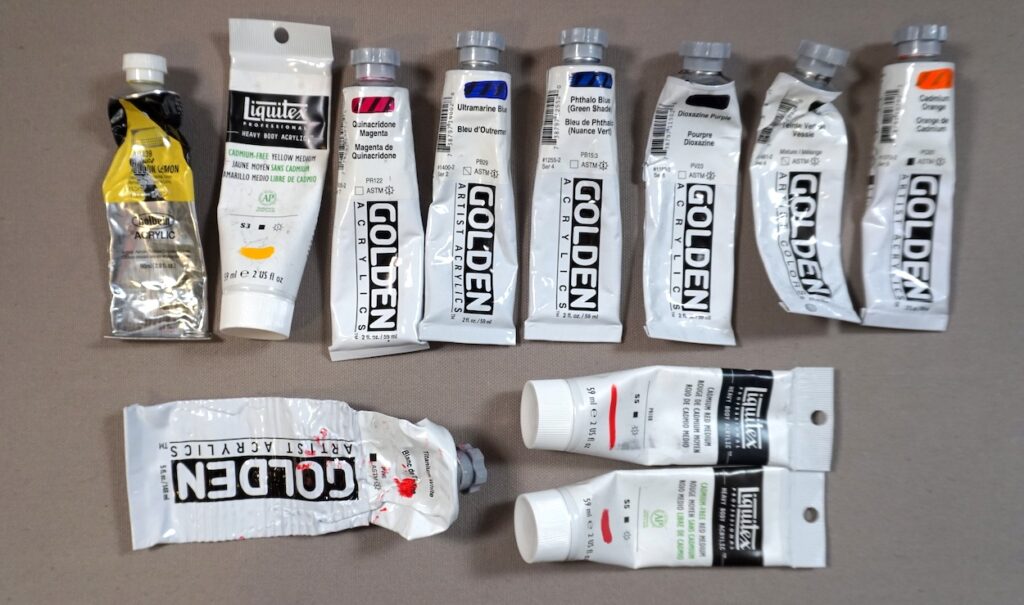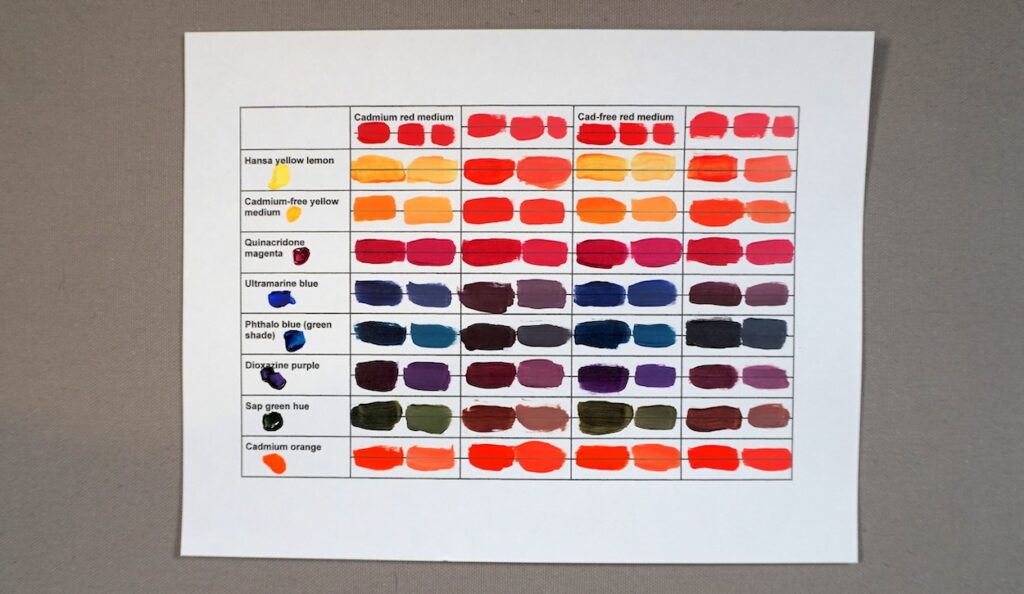This page contains affiliate links. As an Amazon Associate I earn from qualifying purchases. Read the full disclosure.
A few years ago, Liquitex launched a new set of acrylic paints – a cadmium-free version of their cadmium paints. This wasn’t your average cadmium-free alternative. Liquitex claims that artists can’t tell the difference between the two.
Real cadmium acrylic paint
Cadmium paints are beloved by many, many artists because of their strong tinting strength and opacity. They’ve very bright and have excellent lightfastness. Depending on how cadmium is treated, it can range from a bright lemon yellow to a dark, intense red. It’s also quite expensive. A single tube of cadmium paint can be several dollars more than a non-cadmium equivalent. The first cadmium colour, cadmium yellow, was discovered in the early 1800s. It wasn’t until the early 1900s that cadmium red was discovered.

Why cadmium-free?
Cadmium is a heavy metal and some people are concerned with the health and environmental consequences of using it in their acrylic painting. Some artists claim it’s not a danger in acrylic paints while others don’t feel the need to take the risk.
I have been using Liquitex’s cadmium-free red acrylic paints since they came out because I fall into the camp of people who don’t feel the need to use true cadmiums. I’m not overly concerned either and haven’t stopped using cadmiums completely. My plan is to use up and cadmium tubes I have and replace with cadmium-free. Recently though, I was in the art store and went to pick up some tubes of cadmium-free red medium and cadmium-free orange. They didn’t have any cadmium-free orange available and instead of the cadmium-free version of red medium, I accidentally grabbed a cadmium version! Because of that mistake, I’m able to do this comparison post.
But what about hues?
These Liquitex paints are labeled as cadmium-free and shouldn’t be confused with other non-cadmium versions labelled as cadmium hues, which are also paints that mimic cadmium paints and also tend to look a bit different, either with their chroma, opacity or both. They are also usually less expensive than their cadmium versions.
Watch me compare real cadmium to cadmium-free acrylic paint on my Youtube channel.
Cadmium red medium
The tube I’m looking at today is Liquitex’s cadmium red medium. The pigment code is PR108 and it’s a fairly pricey tube of paint, like all cadmiums. It’s a beautifully opaque orange-red colour.
Cadmium-free red medium
Liquitex has a cadmium-free version of red medium, which I have used extensively over the past few years. It’s also an opaque orange-red and is labelled as non-hazardous.
Interestingly, and one of the more controversial aspects of Liquitex’s cadmium-free line is that they do not share any pigment codes. They label it as a proprietary formula. This goes against the expectations that artist-quality paints are labelled with their pigments. Artists use pigment labelling information to select paints that are predictable. If the pigment isn’t labelled, then you never fully know what you’re using and if the manufacturer changes the pigment in future batches.
Liquitex’s cadmium-free paints are also as expensive as cadmium paints, so you won’t save any money by using them.
Comparing cadmium and cadmium-free acrylic paint
I’ll compare a few aspects of the two tubes, including opacity, tinting strength and how they mix with other colours. For the colour mixes, I use the following to compare:

- hansa yellow lemon
- cadmium-free yellow medium
- quinacridone magenta
- ultramarine blue
- phthalo blue (green shade)
- dioxazine purple
- sap green hue
- cadmium orange
- titanium white
Results
Overall, I couldn’t tell the difference between real cadmium red medium and cadmium-free red medium. As I worked my way through the mixes, they both had very similar outcomes. It was like using two of the same tube of paint. The colour mixes were extremely similar, and the opacity and tinting strength were essentially the same. Someone with a very exacting eye for colour might be able to see the difference but I don’t really.

I did a pair of quick sketches of an apple and again, both cadmium red medium and cadmium-free red medium both seemed the same.

I will continue to choose cadmium-free paints when I have the option because they are so similar. I do wish Liquitex would label the tube with the pigments because that is valuable information, and I would like it to be less expensive than cadmium paint as well.
Learn more
Check out a listing of all my colour mixing blog posts and videos on my colour mixing roundup article.
Get your own
Pick up your own tubes of cadmium or cadmium-free acrylic paint at your local art store or on Amazon:



